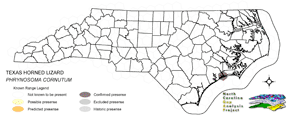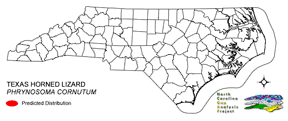
| Taxa: |
| Order: |
| Family: |
| Reptilia |
| Squamata |
| Phrynosomatidae |
| NatureServe Global Rank: |
| NatureServe State (NC) Rank: |
| G4G5 |
| SE |
| Federal Status: |
| NC State Status: |
| --- |
| --- |


| Land Unit |
| US Fish & Wildlife Service |
| US Forest Service |
| US National Park Service |
| US Department of Defense |
| NC State Parks |
| NC University System |
| NC Wildlife Res. Com. |
| NC Forest Service |
| NC Div. of Coastal Mgmt. |
| Local Governments |
| Non-Governmental Org. |
| Other Public Lands |
| Private Lands |
| GAP Status 1-2 |
| All Protected Lands |
| Statewide |
| Hectares |
| 0.00 |
| 349.20 |
| 406.98 |
| 0.00 |
| 0.81 |
| 0.00 |
| 0.00 |
| 0.00 |
| 0.00 |
| 9.27 |
| 3.96 |
| 0.00 |
| 838.71 |
| 15.93 |
| 770.22 |
| 1,608.93 |
| Acres |
| 0.00 |
| 862.89 |
| 1,005.67 |
| 0.00 |
| 2.00 |
| 0.00 |
| 0.00 |
| 0.00 |
| 0.00 |
| 22.91 |
| 9.79 |
| 0.00 |
| 2,072.50 |
| 39.36 |
| 1,903.25 |
| 3,975.75 |
| % of Dist. on |
| Prot. Lands |
| 0.0 % |
| 45.3 % |
| 52.8 % |
| 0.0 % |
| 0.1 % |
| 0.0 % |
| 0.0 % |
| 0.0 % |
| 0.0 % |
| 0.5 % |
| 0.5 % |
| 0.0 % |
| 0.0 % |
| 2.1 % |
| ----- |
| ----- |
| % of Dist. on |
| All Lands |
| 0.0 % |
| 21.7 % |
| 25.3 % |
| 0.0 % |
| < 0.1 % |
| 0.0 % |
| 0.0 % |
| 0.0 % |
| 0.0 % |
| 0.6 % |
| 0.2 % |
| 0.0 % |
| 52.1 % |
| 1.0 % |
| ----- |
| ----- |
|
Palmer and Braswell (1995) recognize an introduced but established population on the coastal plain in Onslow County. Eggs are laid in nests dug an average 15 cm deep (Martof et al 1980). NATURE SERVE GLOBAL HABITAT COMMENTS: Open arid and semiarid regions with sparse vegetation; grass, cactus, scattered brush or scrubby trees. Soil may vary in texture from sandy to rocky. Burrows into soil, enters rodent burrow, or hides under rock when inactive. Sheffield and Carter (1994, Herpetol. Rev. 25:67-68) reported individuals that climbed 1-2 m up tree trunks when soils were wet after heavy rains. Eggs are laid in nests dug in soil or under rocks (Collins 1982). |
| Code | Name | Description | NC Natural Heritage Program Equivalent |
| 42 | Xeric Longleaf Pine | Sandhills including a range of longleaf pine density from predominantly wiregrass, scrub oak dominated to true longleaf pine woodland. This does not include mesic or saturated flatwood types. | Xeric Sandhill Scrub, Pine/Scrub Oak Sandhill, Coastal Fringe Sandhill |
| 46 | Xeric Oak - Pine Forests | Mixed forest dominated by yellow pines with white or northern red oaks co-dominating. | Pine Oak Heath |
| 214 | Barren; bare rock and sand | Areas of bare rock, sand or clay. | No equivalent |
| 60 | Sand | Exposed sand, predominantly in the sandhills region where disturbance or the extreme site conditions prevent natural regeneration. | No equivalent |
|
Price, A. H. 1990. PHRYNOSOMA CORNUTUM. Cat. Am. Amph. Rept. 469.1-469.7.
Conant, R. and J. T. Collins. 1991. A field guide to reptiles and amphibians:eastern and central North America. Third edition. Houghton Mifflin Co., Boston, Massachusetts. 450 pp. Palmer, W. M., and A. L. Braswell. 1995. Reptiles of North Carolina. North Carolina State Museum of Natural Sciences, University of North Carolina Press, Chapel Hill, North Carolina. Webb, R. G. 1970. Reptiles of Oklahoma. University of Oklahoma Press, Norman. 370 pp. Behler, J. L., and F. W. King. 1979. The Audubon Society field guide to North American reptiles and amphibians. Alfred A. Knopf, New York. 719 pp. Martof, B. S., W. M. Palmer, J. R. Bailey, and J. R. Harrison, III. 1980. Amphibians and reptiles of the Carolinas and Virginia. University of North Carolina Press, Chapel Hill, North Carolina. 264 pp. Collins, J. T. 1982. Amphibians and reptiles in Kansas. Second edition. Univ. Kansas Mus. Nat. Hist., Pub. Ed. Ser. 8. xiii + 356 pp. Hammerson, G. A. 1982. Amphibians and reptiles in Colorado. Colorado Division of Wildlife, Denver. vii + 131 pp. Stebbins, R. C. 1985. A Field Guide to Western Reptiles and Amphibians. Second Edition. Houghton Mifflin Company, Boston, Massachusetts. xiv + 336 pp. |
For more information please contact them at:
NC-GAP Analysis Project
Dept. of Zoology, NCSU
Campus Box 7617
Raleigh, NC 27695-7617
(919) 513-2853
www.basic.ncsu.edu/ncgap